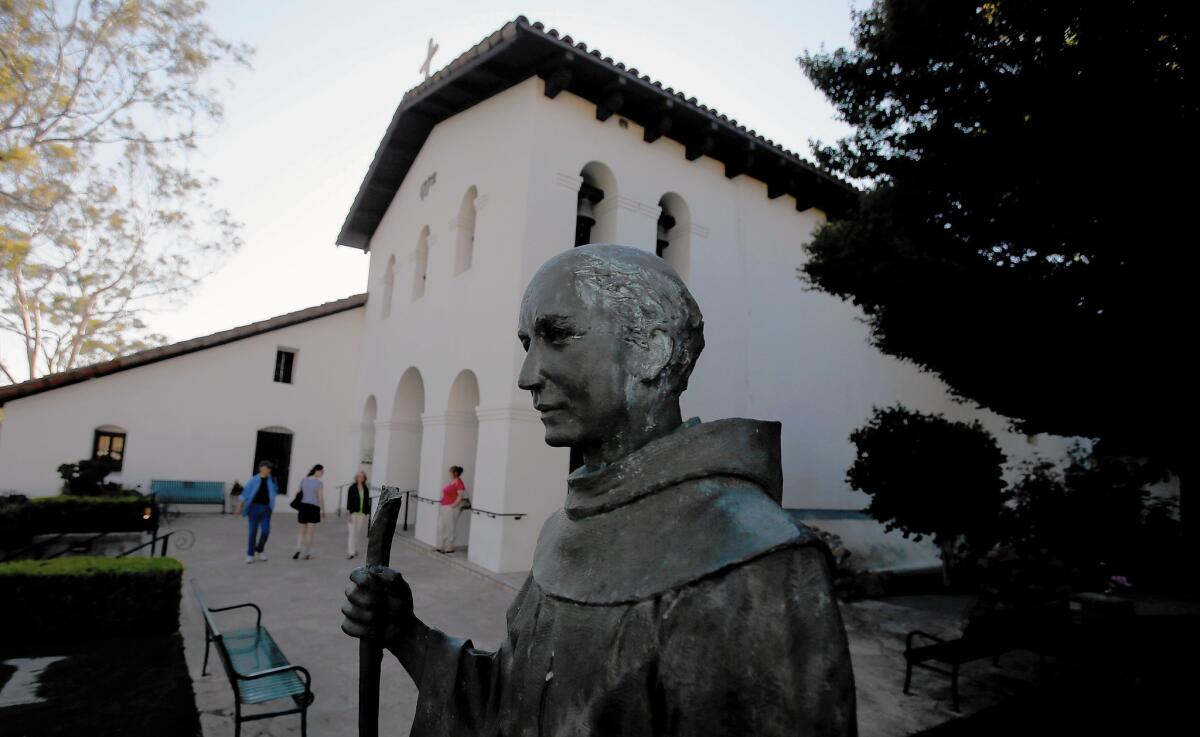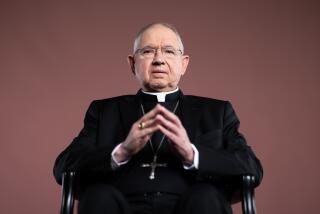Decision to canonize Father Junipero Serra draws divided reaction

He wandered beyond the edge of Christendom into a rugged land of “infidels” he sought to convert.
When Father Junipero Serra and his cavalcade arrived at la bahia de San Diego in 1769, between 225,000 and 310,000 natives inhabited the territory that would become the state of California. The string of missions he and his Franciscan order established would become an origin story for the state, a folkloric tale of vineyards and benevolent friars, taught to students from Modoc to San Ysidro.
Reality was much harsher. The Spanish flogged natives who disobeyed, banned their beliefs and customs, captured those who tried to escape. In the end, they converted less than a quarter of the population, while their livestock and disease destroyed native food supplies and decimated villages.
Serra has been hailed and pilloried as the Columbus of California, an intrepid explorer who opened a bountiful new land to Europeans at the expense of the people already there.
Thus it was inevitable that people would be sharply divided over Pope Francis’ announcement this week to canonize Serra. It’s a debate, said Thomas P. Rausch, professor of theological studies at Loyola Marymount University, that evaluates “an 18th century Catholic missionary by 21st century standards of cultural diversity, religious pluralism and personal autonomy.”
“There’s an enormous bias against Father Serra that may reflect some of the secular notions that are so prevalent today,” he said. “The question we should ask is this: Was the message of the Gospel worth hearing in the first place?”
Some say there is nothing wrong with highlighting the dark side of Serra’s legacy.
“During the Spanish colonial and the Mexican period we lost 90% of the Indians in California,” said Ron Andrade, director of Los Angeles City/County Native American Indian Commission. “Serra was no saint to us.”
Others such as Ruben Mendoza, coordinator of California mission archaeology at Cal State Monterey Bay, say the canonization is long overdue.
“I’ve always felt the canonization process was stymied through misinformation and politicization, and laying blame and onus on one individual who was actually in constant conflict with governors and military commanders in New Spain over how they were treating Indians,” Mendoza said.
He and others said Serra fought efforts to enslave the Indians. And whippings were not limited to natives, but a common method of discipline in the Spanish empire.
“On occasion,” Mendoza said, “I’ve met with American Indian groups who tell their students — 50 to 60 at a time — how the California missionaries raped, plundered and murdered Native American civilization. But I go through Serra’s own documents and I don’t see any of that.”
When the Kumeyaay sacked the San Diego Mission in 1775 — killing three Spaniards — the viceroy captured about a dozen Indians and called for their execution, said Gregory Orfalea, who wrote a biography of Serra. But Serra called for the prisoners’ release and pleaded their case to the viceroy in a letter: “As to the killer, let him live so that he can be saved, for that is the purpose of our coming here and its sole justification.”
In so doing, Orfalea said, Serra modeled his life on the gospel of love — not a desire for land or gold. And in this way, he was different from Columbus, who enslaved and tortured Caribbean natives in his quest for precious metals.
Orfalea said Pope Francis’ decision was no surprise. A Jesuit who took the name after the saint and founder of the Franciscan order, Francis does not believe in Catholicism confined to the ivory tower. Serra was a kindred spirit who abandoned a high-profile academic post to take on the dangerous, austere life of a missionary.
Serra established nine missions between San Diego and San Francisco and baptized 6,000 Indians. He viewed the indigenous tribes as heathens who desperately needed the Gospel. They did not practice agriculture, produce pottery or metallurgy, or build substantial structures. But they had a complex way of living off the land, migrating from the coast to the foothills every year to follow the food supply and weaving elaborate baskets to store and carry their goods. They manipulated the chaparral with fire to produce more food to pick and animals to hunt.
Cattle ranching and sheep grazing led to the collapse of their traditional economy, aided by a later law banning the Indians from burning the landscape. Those who converted were forced to drop their old ways and eat, dress and act like the Europeans.
When Serra died near Monterey in 1784, the mission system was still in its infancy. Ultimately, the system grew to 21 missions.
But Indians began flocking to the missions and the new Spanish towns of Los Angeles and San Francisco as their ancient food supplies dwindled. Smallpox, measles, plague and other diseases spiked as they came together in these tight concentrations, and their numbers plummeted.
Of the 80,000 baptized by the end of the mission era in the 1830s, 60,000 had died, of whom 25,000 were children under 10 years old.
The Yankee invasion and the Gold Rush dealt a final blow. By 1855, only 50,000 Indians were left in California and, with the coming of the railroads, they’d soon be overrun by newcomers.
Serra had set California hurtling toward becoming the Golden Land for people around the world.
Steven W. Hackel, a history professor at UC Riverside, called the announcement of Serra’s canonization “a very exciting moment for California history” and an occasion to revisit and reexamine the state’s distinct colonial experience.
Father Manuel “Tony” Diaz, the administrator of the San Gabriel Mission founded in 1771, said his joyous reaction to the announcement of the padre’s canonization was tempered by the knowledge that some of his own parishioners look upon Serra as a reminder of a lost or frayed tribal history.
“It’s a wonderful testament to the work that he did and the kind of man he was,” Diaz said. But sainthood is “bittersweet,” he said. “We cannot close our eyes to the native people who feel they lost part of their identity when they were evangelized.”
But sainthood doesn’t enshrine absolute perfection, Diaz said
Serra’s canonization has been in the running for decades. Serra was beatified by Pope John Paul II after he was credited with the miraculous cure of a nun in St. Louis suffering from lupus. While beatification requires a miracle, the next step — canonization, or sainthood — requires a second.
But popes are allowed to make exceptions, and Pope Francis said on Thursday that because Serra has been considered a holy man for centuries and was “a great evangelizer,” he would waive the rules for him.
About a decade ago, the Vatican appointed the Rev. John Vaughn, a Franciscan priest at the Santa Barbara Mission, as Serra’s advocate, known officially as the vice postulator — his public relations man.
Vaughn, 86, said he is waiting for the official word from the Vatican about Serra’s canonization.
Asked about Serra’s critics, Vaughn said, “I don’t know how else to put it, but if we want to look at the faults of some of the things Serra did, we’d have to say the same thing about a number of American presidents. They were people of their own time.”
Louis Sahagun contributed to this report
More to Read
Sign up for Essential California
The most important California stories and recommendations in your inbox every morning.
You may occasionally receive promotional content from the Los Angeles Times.













